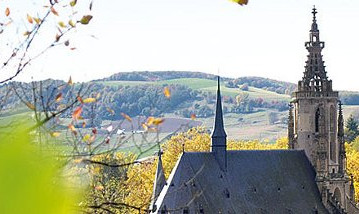 City history
City history
During this time, the place Meisenheim went as a fief to the Counts of Veldenz, who moved their headquarters here. On March 22, 1315 they received city rights for Meisenheim for loyal services from King Ludwig the Bavarian, which made it the political and economic center of the lower Glantal.
Large parts of the city wall erected at that time are still preserved today, including the lower gate, the coin tower and the town tower.
When the dukes of Pfalz-Zweibrücken, a branch of the Wittelsbach family, inherited the Veldenz family in 1444, Meisenheim's heyday began, which can still be seen today in some of the remarkable buildings from this period (castle church, town hall, market hall, Thayn's house, Knight's hostel, aristocratic courts and town houses). In alternating succession, the city was the residence, secondary residence and widow's seat of the duchy.
In 1815 Meisenheim came to Hessen-Homburg; Landgrave Friedrich Josef used the castle as a summer residence for himself and his wife, a daughter of George III. from England. The high couple liked to stay here. This can be seen from the fact that the Landgravine had the old castle, built in 1614 and bought in 1826, expanded by her senior building officer, Georg Moller from Darmstadt, with a larger side wing and at the place where the old castle from Zweibrücken time was up to then Parts of the building stood, had a palace garden with terraces laid out. The princely seat, which was newly constructed with a great understanding of art and at relatively high costs, became so dear to the landgrave and his wife that they spent several months in Meisenheim every year. With the rich means that his wife had brought him into the marriage, the landgrave did a lot to beautify the city.
In the following years the former cityscape remained largely untouched, so that this, viewed as a whole, is a monument; Monument to an eventful, checkered history. The monument preservation and urban development efforts of the last decades testify that Meisenheim is still preserving its valuable cityscape, and thus make the historical city tour an unforgettable experience for the visitor.
Historical city tour
Citizen Tower
The town tower from the early 14th century once served as a debt prison in addition to the defense on its second floor if a debtor could not pay or provide a secure guarantor. By the end of the 17th century he was presented with a roundabout.
Catholic Church
Appointed by Louis XIV in 1680, the Cologne Franciscan Chapter decided to found a monastery in Meisenheim. In 1685 the foundation stone was laid and in 1688 the church in honor of the patron saint, St. St. Antonius´ of Padua, which was built according to plans of the monastery brother Franz Matthias Heyliger. It was provided with a ridge turret, and a tower was only added in 1902 in the Baroque style.
Former Lutheran Christian Church
Built 1761 - 1771 by master bricklayer Christian Reheis according to plans by the lordly agricultural director Philipp Heinrich Hellermann (1765-1776), supported by Christian IV. Von Pfalz-Zweibrücken (1735 - 1775). The simple baroque building with arched windows and hipped roof, ridge turrets with two lanterns and a Welscher hood served the Lutherans as a place of worship until the church union in 1836. From 1911 Protestant parish hall. The city of Meisenheim has been using it as a parish hall since 2005.
Mohren Pharmacy
(Marketplace 2)
Typical Renaissance building around 1550/1560. Seven axes emphasize the broad positioning of the stone building, the three floors of which are separated by ledges. The round bay window on the corner houses portraits in medallions on the protrusion. A pharmacy has been operating here since the 17th century.
Market hall
The elongated, two-story building has six double window axes. It is designed on the ground floor as an open portico with ten Tuscan columns. The upper floor consists of a closed half-timbered facade. A monopitch roof covers the entire building; it is hipped down towards Untergasse. The years 1550 to 1560 are assumed to be the construction date. The city is said to have been the builder. In 1764 it was converted into a guard room, prison and apartment;
The half-timbered structure was uncovered in 1930, and in 1939 the open market hall was restored with new sandstone pillars.
Late Gothic town hall 1508
The construction of the town hall testifies to the comparatively great prosperity of the town at the beginning of the 16th century. Master builder and stonemason Philipp von Gmünd once again demonstrated his skills with this neat late Gothic building around 1508. The large hall on the ground floor was used as a fruit market hall and served as a storage place for civil weapons and pokers, ladders and leather buckets. The council chamber was upstairs. There was an inn on the upper floor as early as 1528 and 1529. The beautiful Renaissance portal leads inside to a spiral staircase, which was only built in around 1580. In 1611 the building was given a roof turret, from where a fire alarm was presumably given. Another extension took place in 1934 in Rathausgasse after the neighboring property "Affenstein" had been acquired. In the years 1991 to 1994, the renovation measures to the present day structure were carried out. The town hall is used today for urban matters (meeting room, mayor's room) and otherwise serves as a day care center for the elderly and a city library.
Princeward court
The Lehenshof (16th century) belonged to the Lords von Fürstenwarther, descendants of Duke Friedrich Ludwig von Pfalz-Zweibrücken and his wife, Glöckner's daughter Maria Hepp, from 1711 to 1853. They were raised to the status of barons in 1711. The coat of arms above the balcony door shows on the left: von Fürstenwarther (woman with trinity flower on the tower), and on the right von Kellenbach (lion).
Steinkallenfelser and Kellenbacher Hof
The buildings erected around 1530 have a common courtyard entrance and share an inner courtyard. The pointed arch of the entrance with the ribbed vault and the stair tower are worth mentioning. On the north side of the building there is an eaves lane into which a toilet bay protrudes.
Knight's hostel
At the fork in the road from Obergasse to “Luisengässchen” (vernacular) rises a half-timbered semi-detached house, built around 1580, the northern half of which is two-story, the southern half is three-story. The gable of the northern part of the building marks the fork in the road: The popular name "Knight's Hostel", however, cannot be found in the archive documents. It is believed that members of local knight families used to meet and drink here. Possibly the knight's hostel was used for the overnight stay of foreign nobles in the city of Meisenheim. The door and window frames of this property at Obergasse 4 were changed in 1725.
Amtsgasse 11
The house at Amtsgasse 11 was probably built around 1630. With its half-timbered construction, it sets an urban accent opposite the square in front of the castle church.
Castle Church
The castle church, first mentioned in 1279, is the most important building in Meisenheim in terms of art history, the cornerstone of which was laid in 1479 by the master builder Philipp von Gmünd on behalf of Ludwig the Black, Count Palatinate of Zweibrücken. The building was completed in 1504 under Palatine Count Alexander von Pfalz-Zweibrücken. Together with the Herzog-Wolfgang-Haus, the castle church forms the only remaining remnants of the former castle.
The three-aisled hall church consists of five bays and a splendid tower with buttresses crowned by pinnacles. He wears an openwork spire with a graceful four-sided lantern and a gallery. The square vestibule is flanked by a burial chapel and a two-story sacristy. The net vaults rest on round pillars with an octagonal base and spire. In the forechoir and choir polygon there are rich domed star vaults. The most elaborate vault is in the burial chapel south of the vestibule. In 1765 - 1767 the Stumm brothers, Rhaunen-Sulzbach, installed a generously proportioned organ. According to the Hague Convention for the Protection of Cultural Property, the Castle Church is one of the RLP's cultural monuments worthy of special protection. It is the most important late Gothic building in the Nahe area.
Yellow House "
The "yellow house" is likely to date from 1497. At that time the Johanniter-Komtur had this building built for his friars, which served as a Johanniterkommende until 1532. Later, the manorial country writing was housed here. In the 17th century a covered footbridge was built towards the palace square.
In a document from 1349 it is said that the “yellow house” in the Amtsgasse is the oldest half-timbered house in the Glan area.
Thayn’s house
(Untergasse 54) Magnificent half-timbered house from the 16th century. It towers over the other town houses in size, age and beauty. For many it is considered the most beautiful three-story town house in Meisenheim. On the courtyard side there is a stair tower with a spiral staircase.
Lower gate
The only remaining gate of the city was built in 1315 after the granting of city rights by Emperor Ludwig the Bavarian. The lower part with the high pointed arch, in which the portcullis ran, probably dates from this time. The inner gate and the windows above are from the renovation in 1847. The upper edge protrudes a little. Small late Gothic corner turrets protrude on three sides on consoles on its corners. However, these are not fully preserved. Today's eight-sided pyramid, which faces the city, was erected after 1689. On the left side of the tower a staircase leads to the battlement. The tower keeper, who had to watch over the peace of the city, lived on the top floor. If guests wanted to be admitted at night, he had to call the mayor, because he was only allowed to lower the drawbridge and open the small entrance gate in his presence.
The view of the square-shaped lower gate made of quarry stone with corner humps and the slate octagonal pyramid-like tower help to make the comparison with Rothenburg. In connection with the half-timbered houses, the visitor gets the impression of the medieval townscape.
Reporting area with fountain
The oldest recorded mention of the name "Rapportierplatz" dates back to 1653. The name of the square goes back to the fact that the vigilante group once had to report here.
A fountain has stood on the square since 1938. Sculptor Emil Cauer the Younger (1867-1946) created the fountain figure of a boy with two tits in his hands.
House of Encounters
The former synagogue, today the “House of Encounters”, was built between 1864 and 1866 at Saarstrasse 3 after the old prayer house in Lauergasse had become too small. The Meisenheim synagogue is now considered to be the most artistically demanding of the synagogue buildings preserved in the Bad Kreuznach district. The hall-like building made of unplastered local sandstone faces the street with its gable-sided, representative front. The building has been in the care of the “Meisenheim Synagogue Support and Support Association” since 1985, was renovated in 1986/87 and is now used for cultural events.
Boos from Waldeckscher Hof
One of the oldest properties in the city is the former Adelshof at Obergasse 26, which, after careful and gentle restoration, offers an attractive eye-catcher at the entrance to the historic old town. From 1422 to 1806 the farm was exclusively owned by the Boos von Waldeck, who served the dukes of Pfalz-Zweibrücken for centuries.
Inspector's House
The house with the gable, Obergasse 19, with exposed framework and stair tower with an octagonal floor plan was built around 1600. Later it came into the possession of the lordly government, and after 1727 it served the Lutheran congregation as a pastorate. The clergyman Johann Nikolaus Götz, also known as the “Winterburg Nightingale”, lived here and wrote many of his poems here.
Herzog Wolfgang House
Built in 1614 as the widow's seat of the Countesses Palatinate in Zweibrücken. 1825-1827 neo-Gothic extension by Georg Moller, Darmstadt, as the summer residence of the Hesse-Homburg landgrave couple Friedrich VI. (1820-1829) and Elisabeth, an English princess.
1869 - 1932 seat of the district office of the Meisenheim district. Today there is a curative educational facility of the kreuznacher diakonie here.
Iron bridge over the Glan
The Meisenheim Beautification Association from 1878 built the footbridge between the Herrenschlag and the valley in 1893. The execution took place in steel framework with cast iron posts on stone pillars. In 1998, thanks to the allocation of the country, donations and personal contributions, the footbridge was renewed.
Mill tower
The mill tower, also known as the coin tower, was part of the old city wall and served as a watchtower in 1554. The buildings of the former town mill are in the immediate vicinity.
Station building
(Bismarkplatz 1) The former station building is a good example of historicism around 1900. The combination of style elements from different eras is interesting.
Lettermann's house
The house at Untergasse 16 was originally built in the 17th century. However, the structural condition made it necessary to renovate the foundation walls in 2000. In the upper part of Untergasse, the viewer immediately catches the pretty half-timbered structure. In addition, the beautifully carved wooden door from the famous Meisenheim Schmidt workshop could be rescued and reinstalled. The city-owned building is a contact point for tourists on the ground floor.






